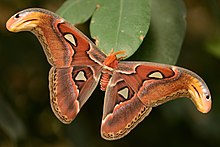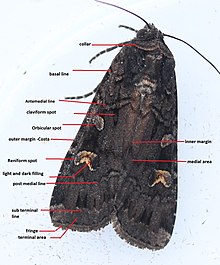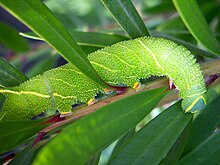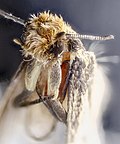Moth
| Moths | |
|---|---|

| |
| Atlas moth, Attacus atlas | |
| Scientific classification | |
| Domain: | Eukaryota |
| Kingdom: | Animalia |
| Phylum: | Arthropoda |
| Class: | Insecta |
| (unranked): | Amphiesmenoptera |
| Order: | Lepidoptera |
| Groups included | |
| |
Moths are a group of insects that includes all members of the order
Differences between butterflies and moths

While the
Although the rules for distinguishing moths from butterflies are not well established, one very good guiding principle is that butterflies have thin
Etymology
The
Caterpillar

Moth larvae, or
History
Moths evolved long before butterflies; moth
Economics
Significance to humans
Some moths, particularly their
Several moths in the family
The larvae of
Items of fabric infested by clothes moth larvae may be treated by freezing them for several days at a temperature below −8 °C (18 °F).[11]
Some moths are
Not all silk is produced by Bombyx mori. There are several species of Saturniidae that also are farmed for their silk, such as the ailanthus moth (Samia cynthia group of species), the Chinese oak silkmoth (Antheraea pernyi), the Assam silkmoth (Antheraea assamensis), and the Japanese silk moth (Antheraea yamamai).
The larvae of many species are
Predators and parasites

Nocturnal insectivores often feed on moths; these include some bats, some species of owls and other species of birds. Moths also are eaten by some species of lizards, amphibians, cats, dogs, rodents, and some bears. Moth larvae are vulnerable to being parasitized by Ichneumonidae.
Baculoviruses are parasite
There is evidence that ultrasound in the range emitted by bats causes flying moths to make evasive maneuvers.
The fungus Ophiocordyceps sinensis infects the larvae of many different species of moths.[19]
Ecological importance
Moths, like butterflies, bees and other more popularly recognized pollinating insects, serve an essential role as pollinators for many flowering plants, including species that bees do not visit. Nocturnal moths fly from flower to flower to feed on nectar during the night much as their diurnal relatives do during the day. A study conducted in the UK found moths dusted with pollen from 47 different plant species, including seven species largely ignored by bees.[20] Some studies indicate that certain species of moths, such as those belonging to the families Erebidae and Sphingidae, may be the key pollinators for some flowering plants in the Himalayan ecosystem.[21][22] The roles of moths as pollinators have been studied less frequently than those of diurnal pollinators, but recent studies have established that moths are important, but often overlooked, nocturnal pollinators of a wide range of plants.[23][24][25][26] Some researchers say it is likely that many plants thought to be dependent on bees for pollination also rely on moths, which have historically been less observed because they pollinate mainly at night. [27]
Attraction to light

Moths frequently appear to circle artificial lights. The reason for this behavior (positive phototaxis) is currently unknown. One hypothesis is called celestial or transverse orientation. By maintaining a constant angular relationship to a bright celestial light, such as the moon, they can fly in a straight line. Celestial objects are so far away that, even after travelling great distances, the change in angle between the moth and the light source is negligible; further, the moon will always be in the upper part of the visual field, or on the horizon. When a moth encounters a much closer artificial light and uses it for navigation, the angle changes noticeably after only a short distance, in addition to being often below the horizon. The moth instinctively attempts to correct by turning toward the light, thereby causing airborne moths to come plummeting downward, and resulting in a spiral flight path that gets closer and closer to the light source.[28]
Studies have found that light pollution caused by increasing use of artificial lights has either led to a severe decline in moth population in some parts of the world[29][30][31] or has severely disrupted nocturnal pollination.[32][33]
Noteworthy moths
- Atlas moth (Attacus atlas), one of the largest moths in the world
- Hercules moth (Coscinocera hercules), largest moth in Australia
- White witch moth (Thysania agrippina), the Lepidopteran with the longest wingspan
- Madagascan sunset moth (Chrysiridia rhipheus), considered to be one of the most impressive and beautiful Lepidoptera[34]
- Death's-head hawkmoth (Acherontia spp.), is associated with the supernatural and evil and has been featured in art and movies
- Peppered moth (Biston betularia), the subject of a well-known study in natural selection
- Luna moth (Actias luna)
- Grease moth (Aglossa cuprina), known to have fed on the rendered fat of humans[35]
- Emperor gum moth (Opodiphthera eucalypti)
- Polyphemus moth (Antheraea polyphemus)
- Bogong moth (Agrotis infusa), known to have been a food source for southeastern indigenous Australians
- Ornate moth(Utetheisa ornatrix), the subject of numerous behavioral studies regarding sexual selection
Moth species that may cause significant economic damage
- Spongy moth (Lymantria dispar), an invasive species pest of hardwood trees in North America
- Winter moth (Operophtera brumata), an invasive species pest of hardwood trees, cranberry and blueberry in northeastern North America
- Corn earworm or cotton bollworm (Helicoverpa zea), a major agricultural pest
- Indianmeal moth (Plodia interpunctella), a major pest of grain and flour
- Codling moth (Cydia pomonella), a pest mostly of apple, pear and walnut trees
- polyphagouspest
- Achroia grisella), pests of bee hives
- Duponchelia fovealis, a new invasive pest of vegetables and ornamental plants in the United States
Gallery
-
Diagram of aplume moth from Robert Hooke's Micrographia
-
Leaf-shaped moth (Pergesa acteus)
-
Giant grey moth (Agrius convolvuli)
-
Oleander hawk-moth or army green moth (Daphnis nerii)
-
Six-spot burnet moths mating (Zygaena filipendulae)
-
Protective silk (or similar material) case (cocoon)
-
A caterpillar of death's-head hawkmoth
-
Mating pair of Laothoe populi, or poplar hawkmoths, showing two different color variants
-
White-lined sphinx moth in Colorado, United States
-
Closeup of a common clothes moth
-
Giant silk moth (Adelowalkeria tristygma)
-
Adult emperor moth (Gonimbrasia belina)
-
A moth on a marble floor in Kolkata, India
-
Clothes moth, eye
-
Femalerose-myrtle lappet mothhanging on the wooden door
-
A moth on artificial flowers in Kolkata, India
See also
- Baculovirus
- Clothing moth
- Comparison of butterflies and moths
- List of moths
- Lepidopterism
- Pollination
- Mothman
References
- ISBN 978-1-4020-6242-1.
- ^ "Moths". Smithsonian Institution. Archived from the original on 2 July 2018. Retrieved 12 January 2012.
- ^ Scoble, MJ 1995. The Lepidoptera: Form, function and diversity. Oxford, UK: Oxford University Press; 404 p.
- PMID 31636187.
- ^ Darby, Gene (1958). What is a Butterfly. Chicago: Benefic Press. p. 41.
- ^ Hoyt, Cathryn. "Evolution of Moths and Butterflies". Chihuahuan Desert Nature Center. Archived from the original on 6 January 2014.
Studying the evolution of butterflies and moths is challenging, since fossils are so rare. But the few Lepidopteran fossils that exist, captured in amber or compressed in fine-grained rocks, show an astonishing amount of detail. The earliest Lepidopteran fossils appear in rocks that are about 190 million years old. These tiny fragments of scaled wings and bodies clearly indicate that moths evolved before butterflies.
- USDA. Economic Information Bulletin Number 11. Archived from the original(PDF) on 14 June 2010.
- .
- ^ ISBN 3-11-010661-2.
- ^ Konkel, Lindsey (28 July 2012). "7 Things You Don't Know About Moths, But Should". Live Science. Archived from the original on 20 January 2021. Retrieved 19 January 2021.
- ^ Choe, D.-H. (21 June 2016). "How to Manage Pests | Pests of Homes, Structures, People, and Pets | Clothes Moths". ipm.ucdavis.edu. University of California, Davis. Archived from the original on 25 June 2007.
- ^ "Table 74. Raw silk: production (including waste)". Food and Agriculture Organization of the United Nations. Archived from the original on 18 March 2008. Retrieved 2 October 2008.
Table lists worldwide raw silk production 132,400 metric tonnes in 2002
- ^ "Silk Exchanges of Tamil Nadu and Andhra Pradesh". Central Silk Board of India. Archived from the original on 7 March 2007. gives silk prices in rupees. Exchange rate is about 50 RS to dollar.
- ^ "Silk Worm Farming". Vegan Society. Archived from the original on 19 June 2008. Retrieved 2 October 2008.
World Raw Silk Production in 1996 is listed as 83,670 metric tonnes
- ^ "Some Edible Species". Food-Insects.com. Archived from the original on 7 November 2014.
- PMID 11467425.
- ^ Kaplan, Matt (17 July 2009). "Moths Jam Bat Sonar, Throw the Predators Off Course". National Geographic News. Archived from the original on 22 August 2009.
- ^ "Some Moths Escape Bats By Jamming Sonar". NPR (video). 17 July 2009. Archived from the original on 10 August 2017.
- PMID 29371523.
- ^ Fox, Alex. "Moths Work the Pollination Night Shift, Visiting Some Flowers Bees Skip". smithsonianmag.com. Archived from the original on 30 October 2022. Retrieved 30 October 2022.
- ^ "National Mission on Himalayan Studies". nmhs.org.in. Archived from the original on 4 November 2018. Retrieved 4 November 2018.
- from the original on 28 October 2018. Retrieved 4 November 2018.
- PMID 32396782.
- ^ Matt McGrath (13 May 2020). "Nature crisis: Moths have 'secret role' as crucial pollinators". BBC. Archived from the original on 13 May 2020. Retrieved 13 May 2020.
- PMID 25914438.
- from the original on 14 March 2022. Retrieved 19 September 2021.
- ^ Kuta, Sarah. "Moths are the Unsung Heroes of Pollination". smithsonianmag.com. Archived from the original on 30 October 2022. Retrieved 30 October 2022.
- npr.org. 18 August 2007. Archivedfrom the original on 8 January 2009. Retrieved 5 April 2018.
- S2CID 205145880.
- ^ "The State Of Britain's Moths". butterfly-conservation.org. Archived from the original on 4 November 2018. Retrieved 4 November 2018.
- PMID 34433571.
- PMID 27251575.
- (PDF) from the original on 27 May 2023. Retrieved 13 June 2023.
- ISBN 978-1-84525-015-7. Archivedfrom the original on 6 August 2020. Retrieved 24 September 2016.
- ^ Brundage, Adrienne (23 March 2009), Other Arthropods of Forensic Importance, Texas A&M University, Texas A&M University Forensic Entomology Lecture
![]() Quotations related to Moths at Wikiquote
Quotations related to Moths at Wikiquote
















